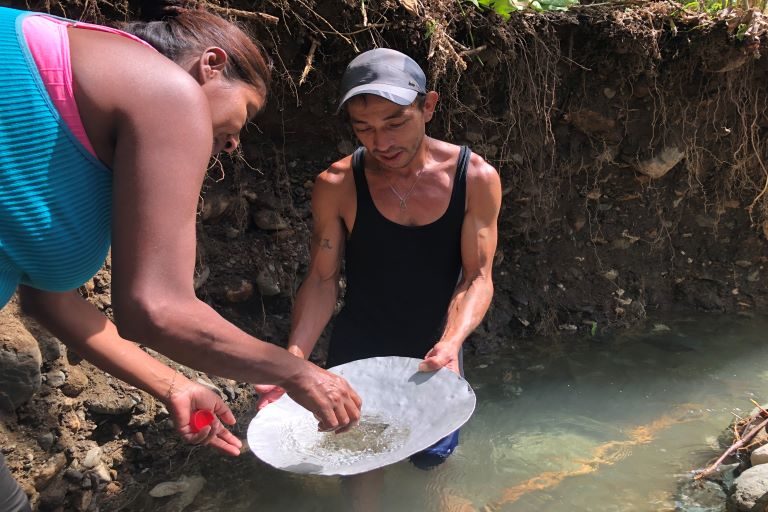Corcovado’s Hidden Crisis
Corcovado National Park, renowned as one of the most biodiverse places on the planet, is facing an unprecedented crisis. Illegal gold mining, fueled by lucrative profits and organized crime, is wreaking havoc on this ecological treasure. The once-protected sanctuary is now under siege, with criminal operations threatening to devastate its delicate ecosystems. This article delves into the alarming rise of illegal mining in Corcovado and the urgent need for action to protect this vital natural reserve.
The Allure of Illegal Gold Mining
At the heart of this environmental crisis is the allure of illegal gold mining. Currently, a single gram of gold extracted from Corcovado fetches around ₡28,000 colones (roughly $52) on the black market. This staggering price has turned gold mining into an irresistible lure for those willing to exploit the park’s remote and dense forests. What was once a sporadic activity has now morphed into a highly organized and well-funded operation, driven by criminal groups that see the park’s isolation as the perfect cover for their illicit activities.
A Sophisticated Operation
The scale and sophistication of illegal mining in Corcovado are deeply concerning. According to Sergio Torres, head of the Prevention, Control, and Protection Program, miners are no longer relying on rudimentary tools. “We have information that people are working in tunnels inside the National Park using sophisticated equipment, including power plants, power tools to break rocks, and metal detectors,” Torres stated. These operations are well-organized, with criminal organizations recruiting workers from vulnerable communities and establishing fully equipped camps deep within the park’s interior. These camps enable miners to extract large quantities of gold over several days before relocating to evade detection.
A Struggle for Resources and Security
Despite the seriousness of the threat, efforts to combat illegal mining in Corcovado are severely hampered by a lack of resources and security. “What we are experiencing is worrisome, and we face many limitations—very little support and no public security. We need significant human resources and equipment to tackle this issue,” Torres added. The situation is further exacerbated by the fact that a staggering 70% of those arrested in connection with illegal mining activities in Corcovado have previous arrest warrants, highlighting the entrenched criminal networks behind these operations.
The Broader Implications
The implications of illegal gold mining extend far beyond the borders of Corcovado. Minister of Security Mario Zamora has emphasized that the gold extracted from the park doesn’t stay local. Instead, it is quickly transported to other parts of Costa Rica and even to neighboring countries like Nicaragua and Panama, where it enters international markets. This not only fuels the global demand for illicit gold but also underscores the transnational nature of the criminal networks involved.
Environmental Devastation
Perhaps the most tragic aspect of this crisis is the environmental devastation it leaves in its wake. The illegal mining operations are causing irreversible damage to Corcovado’s pristine forests, with vast areas being destroyed and wildlife habitats being obliterated. The park, which is home to a staggering variety of species, including many that are endangered, is being transformed from a sanctuary of biodiversity into a battleground of exploitation.
The long-term consequences of this destruction are incalculable. Corcovado’s unique ecosystem, once lost, cannot be easily restored. The environmental damage caused by these activities is not just a local issue but a global one, as the park plays a crucial role in maintaining biodiversity and regulating the climate.
The Need for Immediate Action
Given the scale and severity of the threat, immediate intervention is crucial. The Costa Rican government, along with international partners, must prioritize the protection of Corcovado National Park. This means not only increasing the resources and manpower dedicated to combating illegal mining but also strengthening law enforcement to dismantle the criminal networks behind these operations.
Public awareness is also a key component of this effort. The more people understand the value of Corcovado and the dangers posed by illegal mining, the greater the support for conservation efforts. This is not just about saving a park; it’s about preserving a critical part of our planet’s natural heritage.
Corcovado National Park is more than just a piece of land; it’s a living, breathing ecosystem that supports a vast array of life. The illegal gold mining crisis threatens to destroy this irreplaceable treasure, and the time to act is now. The future of Corcovado, and the countless species that call it home, depends on our willingness to confront and stop these illegal activities. It’s a challenge that requires collective action, but one that we cannot afford to ignore.

